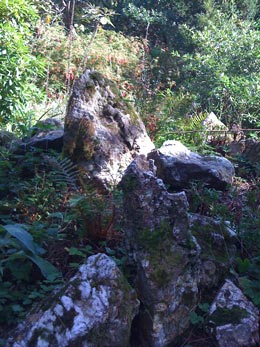Posted on 1 November 2013 by Buddhism Now
 We human beings are all farers through life and will traverse pathways of many different kinds — tranquil woodland paths, busy city streets, highways, byways, even soulless, preoccupied motorways. Late and in a traffic jam, one mood can trigger another, taking us into an emotional turmoil of frustration, anxiety, anger, and enter into a different kind of transport which carries us away to involuntary destinations. So much for bodily as well as emotional journeys!
We human beings are all farers through life and will traverse pathways of many different kinds — tranquil woodland paths, busy city streets, highways, byways, even soulless, preoccupied motorways. Late and in a traffic jam, one mood can trigger another, taking us into an emotional turmoil of frustration, anxiety, anger, and enter into a different kind of transport which carries us away to involuntary destinations. So much for bodily as well as emotional journeys!
Then there are intentional pathways of exploration and experimentation of the thinking, reasoning mind, as we follow trains of thought taught by others, and to which we are hoping to add our own theories and discoveries. There are pathways follow by choice or inclination, and some on which we are led by the nose.
There is also a path, however, which accompanies us in parallel with the others, consciously or unconsciously creating our karmic path, a path of consequences set in motion from our earliest consciousness. This cuts a psychological route through the egoic and shadowy formations which confront us through life and which are often ascribed to ‘fate’ — whatever that means!
This brings us to the consideration of the even more elusive ‘spiritual’ path. What is it? Can we choose it, or does it choose us? Where does it lead? And there is the greater question of developing the capacity for spirituality — irrespective of choice, upbringing, outside authority or label — just by ourselves, just by our relationship to the mind of consciousness/unconsciousness, and what surprises this produces in life.
But first there is the maze which has to be negotiated. It is by definition a labyrinth — tortuous and serpentine — intended to confuse and disorientate. This brings us to the title: Brahma Faring in 21st-Century Mazes. The mind, because of its various functions, monkey origins, and self-deceptions, is very like those fascinating hedge mazes with their convolutions of temptation and the predicaments into which they lead us.
By the time we have experienced enough to recognise how much more confined we can be by our own mental development than by anything else outside, we have probably already reached that point in our maze where we want to call a halt and ask, ‘Where am I?’ Perhaps the answer is, ‘Amazed to find that we really have become be-mazed.’ Then we react according to our individuality. If we do not know how to get out of a hedge-maze, we ask the man on the platform. He tells us and we are soon free.
But the spiritual life is different. Unchosen, it is lived from both conscious and unconscious regions and becomes a quest into ancient unmapped territory, unpredictable, with no one on a platform. It is a way to be found. Suddenly we find ourselves alone, lost in a maze of our own making — not one of our own design, but from which there is no going back. Here, I am reminded of Jung’s words: ‘We have to be alone if we are to discover what it is that supports us when we can no longer support ourselves.’ He knew because he was once in such a situation. Likewise, the Buddha when he went from home to the homeless life. Eventually we too have to accept that deep down we are really responsible for ourselves.
If, hitherto, we have simply been ‘going with the 21st-century flow’, swept along by self-interest, weaving or fighting our way through worldly options and obstructions on behalf of me and mine at the centre, then our view of the world will grow evermore asymmetrical. We may think we are taking a middle way, but are actually approaching the edge of a waterfall and are liable to fall into conflicts and confusions for which 21st-century drugs and medicines have no answer. The effects of such things, in fact, are more likely to detract from our consciousness and mindfulness, whereas what we need is the opposite! Anything we can retrieve from our unconscious, unaware background is a bonus, an addition to our reality and knowledge of how things really are with ourselves and the world.
The immediate 21st-century danger for the world is, of course, the threat of terrorism, of war, and of an exacerbation of that psychology which underlies terrorist mentality. Does the world know enough about terrorism and its psychological underbelly? Some people think that terrorism abides only in certain places and races, but it can harden in the unexamined mind of anyindividual in whom the seed has been planted.
‘The lust and joy of warlike conflict, without which no human being can be induced actually to fight in a war, is derived from the satisfaction of the unconscious side . . . warfare is the visible expression of the breakthrough of the unconscious shadow side of the collective.’
[Depth Psychology and a New Ethic, Eric Neumann, pp. 5, 7, 8.]
 On what psychological hook are we caught in this particular snare? This is something which has been simmering, unexamined and overlooked as a complex of victim psychology. Unaddressed in the collective unconsciousness, it can influence the mind for many centuries. So let us look into an aspect of our own evolutionary distant past to see how it may be influencing matters in today’s world. For this we need to turn to Jung who, like the Buddha, was prepared to face the worst of the darkness in order to clear the way to light.
On what psychological hook are we caught in this particular snare? This is something which has been simmering, unexamined and overlooked as a complex of victim psychology. Unaddressed in the collective unconsciousness, it can influence the mind for many centuries. So let us look into an aspect of our own evolutionary distant past to see how it may be influencing matters in today’s world. For this we need to turn to Jung who, like the Buddha, was prepared to face the worst of the darkness in order to clear the way to light.
Jung was genuinely interested in the primitive mind, in its state of uninterrupted development prior to the white man’s interference. On a visit to North America he met the Pueblo Indians, made careful observations, and came to many interesting conclusions. He compared their psychological ethos to the plight of the West. In conversation with Chief Ochwiay Biano (Mountain Lake), Jung was told how the central theme of their religious rituals was to help the sun, their Father, to cross the sky each day, because if they did not, the day would come when it would not rise again.
Mountain Lake asked Jung why the Americans did not leave them alone, why they wanted to forbid their sacred dances, and why they made difficulties when they took their young from school in order to instruct them in their religion. Although they did nothing to harm the Americans, the Chief said that the Americans wanted to stamp out their religion. He explained, ‘What we do, we do not only for ourselves, but for the Americans also . . . Yes, we do it for the whole world, everyone benefits from it.’
It soon became clear to Jung that their calm self-confidence was rooted in their meaningful ritual which linked them from their remote region to the whole world and thence to the source of life for the whole world. They and the Great Father were at one. Such was their evolutionary path, their totality, their uninterrupted development, their selflessness. In contrast, Jung wrote:
‘Our Western evolution from a primitive level was suddenly interrupted by the invasion of a psychology and spirituality belonging to a much higher level of civilisation. Still in a primitive state we were forced to adopt a comparatively sophisticated doctrine of Christian love. We were stopped in the midst of a still barbarous polytheism which was apparently eradicated or suppressed in the course of the centuries. I suppose this fact is what has given a peculiar twist to the Western mind. Our mental existence was transformed into something it had not yet reached and which it could not truly be; this could only be brought about by a dissociation between the conscious part and the unconscious; and this happened at the expense of the totality of the individual.’ [CW, Vol. 10, para. 1008.]
When we think of Jung’s discovery of a natural individuation process and its mountainous difficulties in struggling to come to light, we have a measure of how devastating it must be to have such a break in that process.
This forceful imposition of monotheism and impossibly high moral standards on the slow evolutionary process of multi-theism in which people were still learning to live with their gods, was jolted by this imposition into guilt, anxiety, and fear of the new God. To impose doctrine alone is not enough for conversion. The receiving consciousness was still primitive and unready. Psychological twists and turns, therefore, had to be brought into play in order to gain some kind of conformity. This was achieved by the psychological mechanism of repression followed by projection.
‘Projection’ is a word we are beginning to understand, but perhaps have not yet fully done so. We might say that one person is projecting such and such onto another person, but without seeing it in our own behaviour. What happens when people are accused of something they can’t admit to? They routinely blame it onto another. Other people are the villains and they themselves the victims, not realising that in that lie they are victimising themselves, damaging once again their true religious process.
This is the reason it is called scapegoat/victim psychology. We are not talking about real victim situations, such as when someone has been attacked; we are talking about the rejection of responsibility by laying it on the other. This is the consequence of dualistic self/other psychology, and of the projection of guilt. If we can blame somebody else, we achieve instant innocence. The worst dictators the world has ever known have presented themselves as victims. They persecute people and say it is because they have been victimised by them, and that justifies everything. Every holocaust, torture and abuse has been justified in this way.
 We all know what is going on at this moment. Some of those who share ‘the book’ of three great religions in both East and West are at this moment slaughtering one another in the name of a common religious source. What a shocking thing! However, if we can refrain from judgement and taking sides, we will learn a lot about our own victim complexes. With the Middle Eastern suicide bombings, the West has met with its most intractable opposition yet — fundamentalism: draconian law and stagnant religion of which Phiroz Mehta once said, ‘Stagnant religion is the Devil’s fortress.’
We all know what is going on at this moment. Some of those who share ‘the book’ of three great religions in both East and West are at this moment slaughtering one another in the name of a common religious source. What a shocking thing! However, if we can refrain from judgement and taking sides, we will learn a lot about our own victim complexes. With the Middle Eastern suicide bombings, the West has met with its most intractable opposition yet — fundamentalism: draconian law and stagnant religion of which Phiroz Mehta once said, ‘Stagnant religion is the Devil’s fortress.’
Even the suicide bombers themselves are but tragic victims of the stagnant psychology of a tradition which, politically as well as ethically, is destroying itself from within — hence those symbolic suicides, as each side provokes the other into relentless retaliation. ‘Stagnant religion as the Devils Fortress’ is an exact description and can be applied to any psychological state that is stagnant and becomes sick. The West had been suffering from a stagnant self-satisfaction and sense of superiority, as if that too (before September 11) were a permanent state, a last word in power and moral conviction. That, too, is ‘a Devil’s fortress’: intransigence, buttressed with bigger weapons and more money against too much opposition.
All religion in ancient times began in multi-theism with the primal mind feeling itself surrounded by so much that was not understood, not even the understanding of one’s own instincts, which are collectively the archetypal source of the idea of ‘gods’ — as opposed to the growing egoic sense of self which plays an essential, if temporary, part on the long road to higher consciousness.
When projected gods die they fall into the unconscious and become as demons. That is the same as saying that when psychological values no longer serve, they are discredited by consciousness, becoming negative energies which are no longer under conscious discipline, and thus produce symptoms. And so our western religion fell victim itself to the projection process and has suffered under this particular form of scapegoat/victim psychology.
When new values are taken up at the expense of old ones, the new ideas tend to inflate the ego and become the new authorities, but without proper regulation or a sense of responsibility. Such is the see-saw nature of our human history. Looking at Christianity, then, the word ‘Christianity’ means enlightened consciousness; it was brought by Jesus the Christ. His teaching was simple but represented a new psychology of healing akin to the Bodhisattva of compassion. He admonished, ‘Agree with thine adversary,’ ‘Do good to them who hate you,’ ‘Love thy neighbour as thyself.’ But with this advice, he reassured them, ‘Think not that I come to destroy the law, but to fulfil it.’
Of course, it was a message before its time as are all introductions to higher values by their very nature. In the early days of such teaching only a few will be ready to receive it as it is; the majority will interpret according to past conditioning.
The crucifixion brought an abrupt end to the ministry of Jesus. The continuity was lost as the original outflow of the new compassionate view was cut off at source. The simple teacher of forgiveness was forced to become a sacrifice, which he accepted because of his personal integrity, hoping that his example of self-sacrifice would be understood for what it was.
The new consciousness as taught, exemplified and given out by him, today still carries a pure message of salvation through love and forgiveness. As always, however, the healing process depends on the maturity of understanding which determines how the teachings are interpreted. Then, as now, it is those who listen with their hearts and keep the faith, who keep the sacred spark alive throughout the centuries.
Just as religious consciousness evolved — its gods projected into the skies and reflected back — so with the evolution of the intellect, science developed and took over the reins. Technology was then raised to the skies in projection of an ideal for the good and salvation of humanity. Naturally, its use has been just as self-seeking. The point is that all projections of sky gods are simply symbols of hope and aspiration for the future, but they are not realities. At times of change, when higher values are in the offing, they can present a higher consciousness at an acceptable distance whilst it is being assimilated. By the same mechanism, our worst, most evil thoughts and desires can be projected onto other people and nations in the form of propaganda until we can be made to believe anything that is said. Sadly, since the collective mind did not assimilate the lessons of self-examination in the past, it has remained immature and continued to project according to preference. By default, therefore, the negative karma of projection itself ripened and the false ‘good’ world which had been constructed by the accumulation of wealth and power, fell from the skies in a tragic, literal fashion on what is now called ‘Nine Eleven’.
 In the aftermath there was tremendous selfless sacrifice by many people in the vicinity who even gave their lives to help others, and that is the beautiful and true side of all religions of self-sacrifice. However, on the political and media scale, the habitual projections of victim/scapegoating psychology and its propaganda were given stimulation — revenge had been given justification. The immediate reaction of the President was: ‘We will have a Crusade!’ Unfortunately, the word ‘crusade’ has lost its original significance. History has taught us that the Crusades were conducted in coercive and warlike ways. Furthermore, in this century, wars and crusades cannot be fought from a distance. With the Middle Eastern problem of war by suicide, the world really has become a village. When the young of a nation take to suicide on such a scale it is a sign of collapsing ethical foundations.
In the aftermath there was tremendous selfless sacrifice by many people in the vicinity who even gave their lives to help others, and that is the beautiful and true side of all religions of self-sacrifice. However, on the political and media scale, the habitual projections of victim/scapegoating psychology and its propaganda were given stimulation — revenge had been given justification. The immediate reaction of the President was: ‘We will have a Crusade!’ Unfortunately, the word ‘crusade’ has lost its original significance. History has taught us that the Crusades were conducted in coercive and warlike ways. Furthermore, in this century, wars and crusades cannot be fought from a distance. With the Middle Eastern problem of war by suicide, the world really has become a village. When the young of a nation take to suicide on such a scale it is a sign of collapsing ethical foundations.
Even through the troubled times of this and the last century, the reality of our positive karma has been realised by the quiet interpenetration into the Western consciousness of Buddhism. The Buddha went from home to homelessness, from self as home to a selfless state. He too did it at a time of polytheism and was concerned, perhaps, with the dukkha [unsatisfactoriness and suffering] which the apathy of India of that time had created. He saw hopeless suffering all around — disease, old age, death — and he took on the same kind of burden as other religious leaders must have borne. But his teaching (the dhamma) proved to be the perfect antidote to all the ills of projection. How was that? His non-theistic ethos allowed an entirely new approach to the ideal of enlightenment.
It was during his confrontation with Mara [the Evil One], that Buddha realised that gods — our spiritual and physical instincts as projections of the mind — are powerless, and merely psychological crutches. If not challenged, they must eventually collapse with disastrous consequences, and so he set a place for them too and taught them along with ‘the many-folk’, realising with his super-knowledge that either to abolish or condone the gods would be too much of a culture shock for the average person of his day. Having undergone all the danger and suffering involved in such a direct confrontational showdown himself, he opted for a more gradual educational approach for his followers. In that way he avoided a schism. This ‘teacher of gods and men’ created a dharma refuge. By following his tried and tested skilful methods, those wayward energies — the gods and demons who inhabit the living psyche of man — can be brought safely under conscious control and set firmly on the way to Brahma, the self-shining light. It is for this reason that Buddhists begin their practice by going for refuge to the Buddha, his Dhamma, and the Sangha established by him.
Concerning the Buddha, Jung wrote, ‘He cast aside two million gods and introduced man for the first time.’ Being unique in the history of the known religions, this way was also ahead of its time and it eventually left India. However, before his death the Buddha saw to it that steps were taken for its preservation. The oral tradition that began has survived to this day. Now, of course, we also have the teachings in their written form. The history of the twenty-five centuries since has served only to substantiate its veracity.
The non-theistic nature of the teaching has no underlying victim complex to go to war over. Not being authoritarian, it precludes guilt and blame, substituting understanding for all suffering and its causes. It begins with compassion for both self and others. It is pure therapy. The Buddha built in his famous safeguard against blind faith and the stagnation of doctrine when he said, ‘Do not believe this because I say it. Try it out for yourselves.’ That more than anything else has preserved Buddhism as an acceptable, workable, and healthy religion, fit to travel anywhere at a moment’s notice. Now at the greatest time of need, Buddha’s sangha is imprinting his footprints on Western soil, and the dhamma is increasingly in our hearts.
 Buddhism as a religion depends on the teaching of the enlightened mind, a teaching which requires dedicated teacher-practitioners, not just preachers. Then Buddhism and the knowledge of holistic consciousness can be conveyed as a way of development for human beings — from the unconscious dark state, through intuition, practice, hard work and self-denial — in order that the mind can achieve sufficient experience and growth to bloom as a flower from its dark soil. Throughout the history of religion, such growth comes from the darkness to the light. Trees and flowers are symbols even in our dreams of consciousness achieved. And so when we think of Buddha, we think of that process of becoming fully conscious, for which we need his Dhamma and Sangha. In this context Jung said:
Buddhism as a religion depends on the teaching of the enlightened mind, a teaching which requires dedicated teacher-practitioners, not just preachers. Then Buddhism and the knowledge of holistic consciousness can be conveyed as a way of development for human beings — from the unconscious dark state, through intuition, practice, hard work and self-denial — in order that the mind can achieve sufficient experience and growth to bloom as a flower from its dark soil. Throughout the history of religion, such growth comes from the darkness to the light. Trees and flowers are symbols even in our dreams of consciousness achieved. And so when we think of Buddha, we think of that process of becoming fully conscious, for which we need his Dhamma and Sangha. In this context Jung said:
‘Great innovations never come from above; they come invariably from below, just as trees never grow from the sky downwards, but upward from the earth. The upheaval from our world and the upheaval of our consciousness are one and the same.’ [CW, Vol. 10, para 177.]
When Gautama awakened as Buddha, he touched the earth — he earthed transcendence. He saw that mankind did not need any more gods but to awaken to its own human potentiality for wisdom and compassion. He constructed this insight into an educational system of truth and reality. Awakening has everything to do with the conscious effort to develop the Buddha qualities of self-control, compassion, selflessness and other virtues which flourish only in a climate of mindfulness in everyday living. As we learn to practise and place our trust in Buddha and Dhamma, we come to a true appreciation of just how much the growth of the Buddhist religion owes to the strength and integrity of those who have practised well. A steadfast body of Sangha is the enabling factor which daily, in the constancy of their practice, prove the verity of Buddha and Dhamma.
So also the many lay-Buddhists who in their supportive ways are Brahma-farers, many of whom will deepen their own search and follow the pathway to that eventual centre, that still point of consciousness which is without distinction. Anyone who sincerely sets foot on the path of transformation will be guided more and more into the lifestyle of the Brahmacariya [the Holy Life], until just natural inclination leads the way. It really is a matter of where the heart is.
Sylvia Swain has made a lifelong study of the teachings of the Buddha, Phiroz Mehta and Jung. She was a regular speaker at the BPG summer schools and contributor to Buddhism Now. This article is based on a talk given at the BPG 2002 summer school in Leicester.
No comments:
Post a Comment